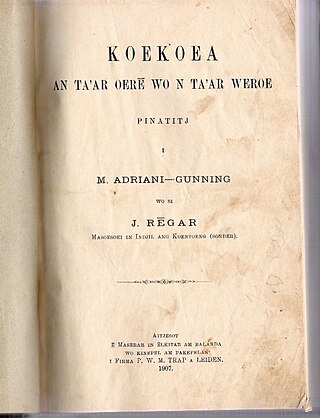The Bauzi or Baudi tribe consists of a group of 2,000 people living in the north-central part of the Indonesian province of Papua. The Bauzi area consists of much of the west side of lower Mamberamo River area in northern Papua. The Bauzi people lived on hunting and gathering in the jungle. While the Bauzi people were historically an animistic people group, they are now 65% Christian. For the most part, tribal warfare is no longer a large part of Bauzi culture and all Bauzi people speak the same language. In recent years, linguists have been studying the language and translating various literature, including the Bible, into the Bauzi language.

The East Geelvink Bay or East Cenderawasih languages are a language family of a dozen Papuan languages along the eastern coast of Geelvink Bay in Indonesian Papua, which is also known as Sarera Bay or Cenderawasih.

The West Papuan languages are a proposed language family of about two dozen non-Austronesian languages of the Bird's Head Peninsula of far western New Guinea, the island of Halmahera and its vicinity, spoken by about 220,000 people in all. It is not established if they constitute a proper linguistic family or an areal network of genetically unrelated families.

The Yawa languages, also known as Yapen languages, are a small family of two closely related Papuan languages, Yawa and Saweru, which are often considered to be divergent dialects of a single language. They are spoken on central Yapen Island and nearby islets, in Cenderawasih Bay, Indonesian Papua, which they share with the Austronesian Yapen languages.

The Asmat – Kamrau Bay languages are a family of a dozen Trans–New Guinea languages spoken by the Asmat and related peoples in southern Western New Guinea. They are believed to be a recent expansion along the south coast, as they are all closely related, and there is little differentiation in their pronouns.

The Mek languages are a well established family of Papuan languages spoken by the Mek people and Yali people. They form a branch of the Trans–New Guinea languages (TNG) in the classifications of Stephen Wurm (1975) and of Malcolm Ross (2005).

The South Bird's Head or South Doberai languages are three families of Papuan languages. They form part of the Trans–New Guinea languages in the classifications of Malcolm Ross (2005) and Timothy Usher (2020), though Pawley and Hammarström (2018) do not consider them to be part of Trans–New Guinea. However, according to Dryer (2022), based on a preliminary quantitative analysis of data from the ASJP database, South Bird's Head languages are likely to be a subgroup of Trans–New Guinea.
The South Halmahera languages are the branch of Austronesian languages found along the southeast coast of the island of Halmahera in the Indonesian province of North Maluku. Irarutu is spoken in the east of the Bomberai Peninsula in West Papua province.
West Bird's Head languages are a small family of poorly documented Papuan languages spoken on the Bird's Head Peninsula of New Guinea.

Dem is a divergent Papuan language of West New Guinea. Although Palmer (2018) leaves it unclassified, it was tentatively included in the Trans–New Guinea family in the classification of Malcolm Ross (2005), and Timothy Usher ties it most closely to Amung.

Mor is a nearly extinct Trans–New Guinea language of Indonesia. It is spoken along the Budidi River and the Bomberai River on the Bomberai Peninsula.
The Abawiri language is a Lakes Plain language of Papua, Indonesia. It is spoken in the village of Fuau, located along the Dijai River, a tributary to the Mamberamo River. Clouse tentatively included Abawiri and neighboring Taburta (Taworta) in an East Lakes Plain subgroup of the Lakes Plain family; due to the minimal data that was available on the languages at that time. With more data, the connection looks more secure.
Semimi, or Etna Bay, is a Papuan language spoken in Kaimana Regency, West Papua, Indonesia.

Tontemboan is an Austronesian language, of northern Sulawesi, Indonesia. It is a Minahasan language, a sub-group of the Philippine languages.
Kuwani is a poorly attested Papuan language of the Bird's Head Peninsula of New Guinea. It is attested only from a single word list, and even its exact location is unknown.
The Badaic languages are a group of three closely related Austronesian languages spoken in the North Lore and South Lore districts in Poso Regency, Central Sulawesi, Indonesia, viz. Bada (Bada’), Behoa (Besoa), and Napu. The three languages are 80–91% lexically similar and to a great degree mutually intelligible, but their speakers are culturally distinct.
Duriankari, or Duriankere, is a possibly extinct Papuan language of Indonesian Papua. It is associated with the village of Duriankari at the southern tip of the island of Salawati, which is part of the Raja Ampat Archipelago and is adjacent to the Bird's Head Peninsula of the West Papuan mainland.
Kepi is a town in Mappi Regency, South Papua, Indonesia. Following the formation of Mappi Regency in 2002, the town became its administrative seat.
Clemens Lambertus Voorhoeve is a Dutch linguist who specializes in Papuan languages.
Piet Drabbe was a member of the Missionaries of the Sacred Heart who worked successively from 1912 to 1960 in the Philippines, the Tanimbar Islands, and on the southern coast of Dutch New Guinea, now the Indonesian province of Papua.









